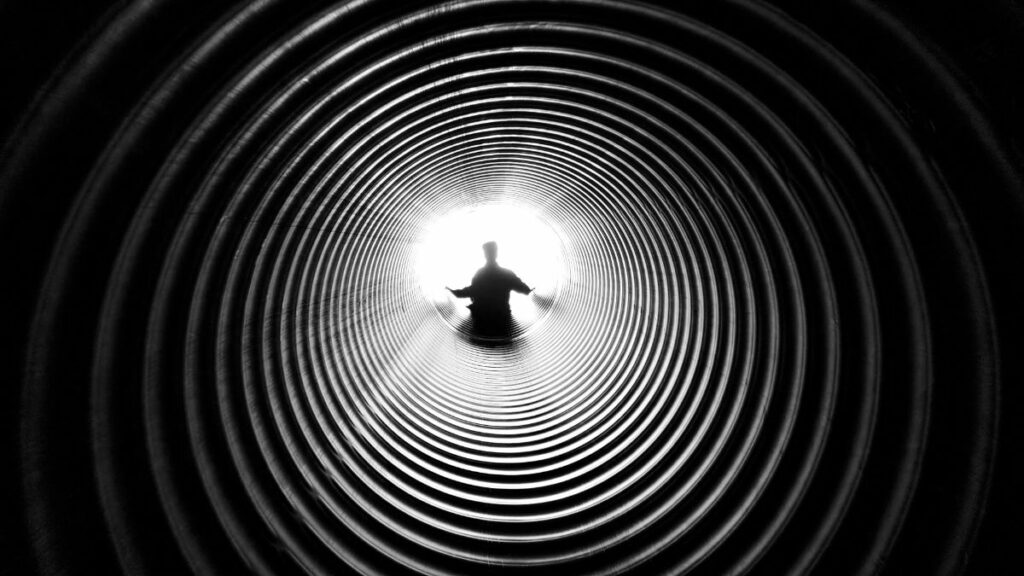What do individuals with tunnel vision actually see?

What is tunnel vision, and how is it caused?
Many of us have heard of the term tunnel vision, but it’s often used when someone is focused on a task and seemingly blind to other things going on around them. What many may not be aware of is that tunnel vision syndrome is actually a concerning and somewhat scary eye condition where a person’s central vision is there, but their peripheral (side) vision is missing causing blind spots in their sight. These vision problems can affect one eye or both and are rather alarming to live with – particularly if it’s never been experienced before.
Unfortunately, there is no one cause of peripheral vision loss. There are many causes that can be the reason for peripheral vision loss, but these will not be identified without a visit to your opticians. Some of the most common causes of tunnel vision include:
Glaucoma
Glaucoma is a common eye condition that affects the pathway sending visual information from the eye to the brain – the optic nerve. Glaucoma can be caused by increased pressure inside the eye and is not always noticed during its early stages. Glaucoma can affect one eye, to begin with, but generally will be apparent in both eyes, and by the loss of vision begins, glaucoma is usually in its advanced stages. Glaucoma can be hereditary, so if you have a history of glaucoma in the family, keep your eyes healthy by seeing a home-visiting optician regularly.
Stroke
Whilst tunnel vision does not happen every time, some stroke sufferers will experience tunnel vision after they have had a stroke, and it can affect both eyes. For those who have recently had a stroke, we recommend having regular eye examinations. For those who have vision loss after a stroke, most people will experience partial or full sight recovery after time.
Migraines
Many of us are aware that migraine headaches are responsible for a variety of vision disruptions, often called an aura. whilst some see shapes and movement; others will experience temporary tunnel vision. This should only last for a maximum of 60 minutes, and if you have experienced tunnel vision for longer than this time frame or with other similar symptoms, we recommend consulting a healthcare professional as soon as possible. If you are worried about tunnel vision during your migraines, book an appointment with your local optician to discuss this further.
What does tunnel vision look like?
For those of us who have not experienced tunnel vision before, we may be left wondering what it feels like – for those of us who have experienced it, we often hope never to be faced with tunnel vision again. Peripheral vision loss can often feel as though you are looking through a narrow tube. your side vision is obscured or missing, causing you to have a constricted view. If you are only experiencing vision loss in one eye, you may not notice it until your healthy eye is closed. This is because our brain is able to compensate for missing vision and will fill in the gaps.
Peripheral vision helps us to see the objects around us without moving our heads. For example, if you are sitting at a desk looking straight ahead, you should still be able to see things to your left and right – maybe a pen and a notepad or your hot coffee and some paperwork. Peripheral vision helps you to sense motion and to walk without falling into things. It’s also how we often see something out of the corner of our eyes. To lose this sight, whether temporarily or on a permanent basis, can be challenging and debilitating for many reasons.
The symptoms of tunnel vision
There are a variety of symptoms of peripheral vision loss; however, as we have said above, you may not even notice it is there until you close your other eye. When you have tunnel vision, objects in your central vision will be clear and unobscured, whilst anything to the corner of your vision – your peripheral vision – will be obscured or completely missing. Depending on the severity of your vision loss, you may notice it straight away or after a period of time. Other common symptoms can include:
- Bumping into people or objects
- Difficulty being in and navigating crowds
- A sudden inability or difficulty to drive
- Tripping over frequently
If you are facing any or multiple of the above symptoms and you are concerned about your vision, we recommend booking an appointment with your local optician as soon as possible so they can conduct a thorough eye examination and advise you of the best course of treatment and next steps.
This may also interest you:
An Opticall guide to protecting the elderly during fireworks season
Stoptober – how does smoking affect your eyesight?
Opticall Eyecare supports clients with tunnel vision symptoms
As a team of qualified and dedicated optometrists, we understand that often there is nothing as important to you as the health of your eyes and your eyesight. If you are facing tunnel vision or think you have the above symptoms when know, you may be feeling worried and confused about how best to navigate this difficult time. Whilst it is difficult to know whether your distorted vision is temporary or permanent, you can rest assured that the Opticall Eyecare team will be here to support you, answer your questions and provide you ongoing advice for the treatment and care of your eyes.
If you are looking for a home-visiting optician that puts you at the centre of the care they provide, look no further than Opticall Eyecare. Get in touch today for more information or to book an appointment.
